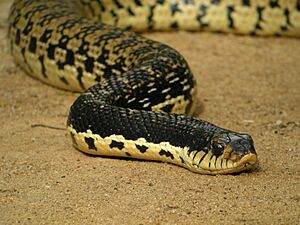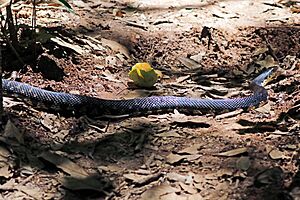Malagasy giant hognose snake facts for kids
Quick facts for kids Malagasy giant hognose snake |
|
|---|---|
 |
|
| at Kirindy Mitea National Park, Madagascar. | |
 |
|
| in Lokobe Strict Reserve, Madagascar. | |
| Conservation status | |
| Scientific classification | |
| Genus: |
Leioheterodon
|
| Species: |
madagascariensis
|
The Malagasy giant hognose snake is a fascinating reptile. It is also known as the Madagascar giant hognose. This snake lives only on the island of Madagascar. It is also found on some smaller nearby islands. These include Nosy Be and Nosy Mangabe. You can also find it on the Comoros archipelago. Some people think it was brought to Grande Comore.
Adult giant hognose snakes can grow very long. They can be between 130 and 180 centimeters (about 4 to 6 feet) in length. This is roughly the thickness of an average adult's arm. Despite its size, this snake is harmless to people.
How the Malagasy Giant Hognose Snake Defends Itself
When this snake feels threatened, it has a special way to scare off danger. It will raise its head and open its mouth wide. It also puffs up the skin around its neck and chin. This makes it look much bigger and scarier. It can even look a bit like a cobra or a bearded dragon in this pose. This trick helps it look more intimidating to predators.
This snake is called "rear-fanged" or opisthoglyphous. This means it has a pair of small, pin-like teeth. These teeth are located at the back of its mouth. They are connected to its upper jaw.
What the Malagasy Giant Hognose Snake Eats
The giant hognose snake uses its rear teeth to help catch prey. It can inject a special saliva through these teeth. This saliva can paralyze its prey. However, studies show that this snake mostly uses constriction to kill its prey. Constriction means it squeezes its prey tightly.
The special saliva helps the snake control "squirmy" animals. This is useful because it takes longer for prey to die from squeezing. The saliva just irritates human skin and is not dangerous. Most hognose snakes do not bite large animals like humans. Their teeth are far back in their mouths. This makes it harder for them to bite big creatures.
The Malagasy giant hognose snake eats many different small animals. Its diet includes various small reptiles, frogs, and toads. It also eats birds, their young, and their eggs. Sometimes, it might eat other smaller snakes. Small mammals like rodents, tenrecs, or mouse lemurs are also on its menu.
Who Are the Predators of This Snake?
The main predators of the Malagasy giant hognose snake are birds of prey. Other bird species that like to eat snakes also hunt them. Some mongooses might eat these snakes too. Even the fossa, which is Madagascar's largest meat-eating mammal, can eat snakes. Fossas usually hunt lemurs, but they will eat other things if they get the chance.
Sadly, the biggest threat to the giant hognose snake comes from people. Many people in Madagascar are very wary of snakes. They often kill these snakes when they see them. This happens even though the Malagasy giant hognose snake is not dangerous to humans.


